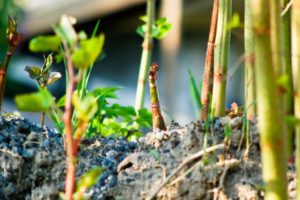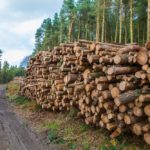News - Construction News
Alien invaders ahead! Are your defences secure?

“Alien invaders” may sound like a movie or a computer game, but this is a real battle that we are already fully engaged with on the land and in the waters of the United Kingdom, writes Dr Phil Aldous, Director of Water, Thomson Ecology.
To find the enemy, you may need to look closely however, as many of these invaders are the most crafty of all hitchhikers. They don’t thumb a lift, they just jump on board for a free ride and then bring change and destruction on arrival. So, what are we talking about? Alien invaders are invasive non-native species (INNS) or invasive alien species (IAS).

As a result of ever increasing globalisation, people and consumer goods can carry invasive non-native species with them when travelling between countries and continents. Ships can translocate aquatic organisms in their ballast water, while smaller boats or plant and equipment may carry non-native species in their water-filled sumps. Other species can find their way into wooden pallets and crates. Some exotic ornamental plants such as Japanese knotweed have become widespread on roadsides, derelict land and riverbanks, supressing the growth of native flora, and in some cases, causing structural damage.
Are you playing your role in protecting the UK’s biodiversity?
So why the alarm and the call to arms? It’s not just the damage that these alien species do in displacing native species – invasive non-native species cost our economy at least £1.7Bn per year. It has been estimated that direct management costs for freshwater INNS in Great Britain is as much as £26M each year.
The EU Invasive Alien Species Regulations (No 1143/2014) introduced new powers to regulators across the EU to control INNS. In the UK this has been implemented via the Infrastructure Act of 2015, with variations across the devolved administrations of Scotland, Wales and Northern Ireland. The Act provides regulators with powers to create Species Control Agreements and Species Control Orders and to impose these on landowners to ensure that action is taken to prevent, control and eradicate INNS. This means that landowners may be legally required not only to control INNS, but to eradicate them altogether. Control Orders allow environmental regulators access to land to establish the presence of INNS, and to implement any necessary control measures. There are subtle distinctions in implementation between England and the devolved administrations of Scotland, Wales and Northern Ireland but overall the principle is the same – the polluter pays. So be aware of any unwanted hitchhikers.
What species are we talking about?
Himalayan balsam and Japanese knotweed are two of the most feared and well known terrestrial invaders. There is a small industry active in their treatment and control. There are plenty of aquatic invaders too, including the quagga mussel and the killer shrimp. Whilst these are present, they remain relatively contained and inter UK catchment transfer is being monitored and restricted. The quagga mussel was first reported in 2014 and is currently restricted to the River Thames and Lea Catchments. The killer shrimp has limited established presence, being found in Graffham Water Reservoir initially and now the Norfolk Broads, two locations in Wales and a further reservoir in Northamptonshire. It’s not just the adult species that pose the risk. Other stages in the life cycles of these species can be just as bad if not worse, as their tiny size makes them more of a threat. For instance, mussel larvae (veligers) can be as small as 40µm – the thickness of a human hair – and because they are able to distort in shape they can pass through even smaller screen filters.
So what next? There are a more species queuing up to hitch a lift, including the water primrose and the round goby. And unfortunately, given climate variability, the UK may well be looking like a nice new home.
Biosecurity and the UK Construction industry
So what role can the UK construction industry play? As you plan to be cybersecure you also need to be bio-secure. Do you have a biosecurity plan for each and every site – and for plant and machinery that moves between each site? If not, you could be giving these unwanted guests a free ride.
For example, water pumps and equipment, and water sports equipment, can provide a significant pathway for the spread of INNS and many can survive for days. For example, zebra mussels can survive outside water for at least five days, and the killer shrimp for at least 15 days. Therefore, the anchor wells, bilges or hulls of boats, on trailers, or in the deep recesses of pumps and machinery equipment used in construction, can be resting homes allowing the INNS to move around freely. Both New Zealand pigmy weed and floating pennywort can reproduce through vegetative growth of fragments as short as 10mm in length, and so are readily dispersed by machinery used to manage vegetation close to, or in, water bodies. With these risks, a biosecurity plan should be part of every site’s environmental management plan.
Prevention is always better than the cure, and the “Check, Clean, Dry” procedure introduced by
The Non-native Species Secretariat, is sensible advice to follow to help avoid the introduction of a wide range of aquatic INNS. All clothing and equipment should be inspected for visible debris (mud, plant or animal matter) and any pockets of pooled water in machinery should be emptied. Equipment should be thoroughly cleaned by hosing down or pressure-washing on site before being transported away. Drying is essential and boots and clothing should be thoroughly dry for 48 hours before being used elsewhere. So leave them on site – don’t take them home. Introduce a boot wash system for all site visitors. Build these procedures into business as usual and undertake an INNS screening of any new site before you start work.
And now you are ready to repel those invaders!
If you would like to read more articles like this then please click here.
Related Articles
More News
- SMEs remain unprepared as cyber threats escalate
19 Apr 24
SMEs neglect cyber security, making them easy targets for a wide range of attacks, including
- I&G to build new Rob Burrow Centre for Motor Neurone Disease
18 Apr 24
I&G has been appointed to build the new Rob Burrow Centre for Motor Neurone Disease
- Glasgow Ship Build Hall progress
17 Apr 24
Turner & Townsend has been appointed as the New Engineering Contract Project Manager to support





